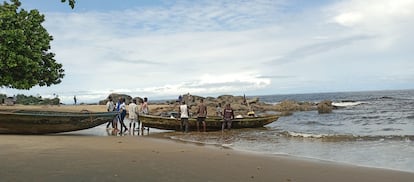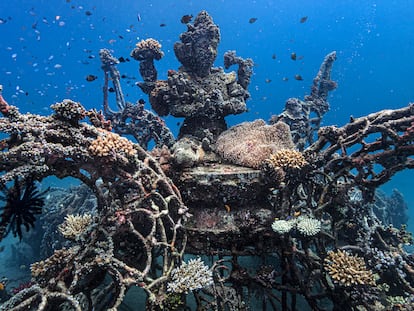Climate change wreaks havoc in Cameroon
With lands that extend into the Sahel in the north, tropical forest in the center and coast in the southwest, the African country is increasingly cornered by desertification, catastrophic floods and rising sea levels

Cameroon is particularly exposed to climate change: its territories in the north extend into the Sahel and are increasingly affected by desertification, while coastal areas in the southwest are threatened by rising sea levels. According to the National Observatory on Climate Change (NOCC), the geographical location of the country makes it “very exposed” to climate-related dangers, such as droughts, floods in its tropical cities, the effects of El Niño, the monsoons and rising water levels along the coast. “All of this has caused an alteration in the pattern and distribution of rainfall throughout Cameroon, [resulting in] extreme phenomena, such as heat waves, rising temperatures, a succession of hot and cold nights, flash floods, as well as the consequences that all of this entails,” explains Patrick Forghab Mbomba, deputy director general of NOCC.
Several recent episodes demonstrate this vulnerability. For the first time in more than a century, the dam atop the hill in the Mbankolo district of the capital, Yaoundé (in the southwest of the country, but far from the coast), is filled with wet mud instead of water. The birds chirp as they build their nests in the twisted branches of the trees amidst this desolate landscape.
The prolonged and intense rains that fell in the Cameroonian capital on October 8 caused the dam of the drainage basin to break. The waters were released downstream, mixing with mud and rocks. The flood destroyed everything in its path, including 50 homes that were precariously built out of wood, adobe bricks and metal sheets. The official death toll stands at 30, but residents insist that many more have died. Several dozen people suffered injuries, while nearly 60 families have been affected. “It came like an atomic bomb,” recalls Jean Ambassa, 24, who witnessed the catastrophe from his home. “I saw how the violent current of water carried away houses and lives. It looked like a movie.”
The dam — built by the Germans during the colonial era (1884-1915) — gave way to the torrential rains that hit the Cameroonian capital. A lack of maintenance also contributed to the collapse. Several climate change experts insist that the landslide could have been avoided. In its bulletin from October 1, the NOCC raised the alarm about the imminent arrival of extreme rainfall in Yaoundé between October 8 and 10. The governmental organization warned of a “very high risk” of flooding.

Fabian Mebara, 49, was the only one in his family who was in the area when the disaster occurred. “The current of water dragged me for more than [500 feet]. I grabbed onto the trunk of a tree,” he recalls. “My house has been destroyed. I’ve lost everything: my television, pots, gas cylinder, bed, telephone, money... the clothes I’m wearing are the only things I have left.”
Yaoundé — nicknamed “the city of seven hills” — is marked by a good number of valleys that can reach up to 2,300 feet high. According to the climate experts consulted, this characteristic of the city of 4.5 million inhabitants exposes it to shifts in the earth.
“Cameroonian researchers and geographers recently recommended that something be done to stop continued human settlement on the slopes,” explains Forghab Mbomba. Due to climate change, more and more variability in rainfall is observed in the southwestern region, where Yaoundé is located. The capital isn’t prepared to divert excess water, which causes floods and landslides. During the rainy season, these episodes occur on an almost weekly basis, in both the capital and in other parts of the country.
Oftentimes, the consequences are fatal. At least 14 people died last November, after an embankment collapsed in the Damas de Youndé neighborhood. And, in 2019, a landslide swept away a dozen flimsy homes built on a hillside in the western region of Cameroon. At least 43 people lost their lives.
“It’s evident that the recurring appearance of these dangers is a consequence of global climate change, which is manifesting itself locally,” Mbomba explains. “Although the severity and degree of damage caused depends largely on the [geography] and type of human activities carried out in the affected area, the design and planning of cities, the general use of the land, the level of awareness about climate change and the degree of preparation [are all crucial factors].”
The sea rises, while the land is degraded
According to a report from the UN Environment Programme (UNEP), climate change affects more than 70% of the population of Cameroon, a country of 27.2 million inhabitants, whose livelihood depends directly on agriculture. This economic activity represents 17% of the country’s GDP. According to the authors of the report, the socioeconomic impact is felt primarily by women, who represent 75% of workers in the informal agricultural sector and are primarily responsible for households.
For a country that relies heavily on natural resources and agriculture, climate change is “an imminent threat to development,” the World Bank emphasizes. Tropical forests, which cover almost 40% of the country, provide some eight million rural residents with basic foodstuffs, natural medicines, fuel and construction materials. However, the financial institution warns that changes in temperature, rainfall and droughts will likely affect these ecosystems, putting rural people at greater risk of suffering from more poverty. According to the UNEP, under current climate conditions, around two million of Cameroon’s 27 million people live in drought-affected areas, while around 8% of the country’s GDP is vulnerable.
Along Cameroon’s 300 miles of Atlantic coast in the southwest, the impact has to do with rising sea levels, coastal erosion, mudflats and huge waves that uproot mangroves and coconut trees. The affected coastal communities — including Douala, the city considered to be the economic center of the country — use sandbags, fences and logs as ways to hold off the water (although they haven’t had much success).
“Today, in Cameroon, there are numerous regrettable examples of sea incursion on the coast, which results in the destruction of piers, beaches and homes,” explains Isaac Njilah Konfor, a groundwater expert and associate professor of Geology at the University of Yaoundé. The worst, he warns, is yet to come to the Cameroonian coast if “immediate measures” aren’t taken. “The floods in Douala, very destructive and frequent, although attributed to poor urbanization, are also closely linked to rising sea levels,” he emphasizes. “The beach — which, 30 years ago, was more than 300 feet from the Kribi highway — is now threatening the road. According to my calculations, the road that connects Kribi with the rest of the world will be cut off in the next two years.”
In addition to threatening or destroying restaurants and homes, the massive waves have caused drownings and have affected fishing activities. Two fishermen died in the water on a beach in Kribi this past October 9. And half-a-dozen more fishermen lost their lives as a result of violent ocean currents in August. “The waves were so strong in August that they overwhelmed the beach and crossed the nearby road,” recalls Ida Kwedi, 62, who lives in Kribi. This mother of four — who has been selling fish for 30 years — explains that fish “become scarce” when sea levels rise. “The water currents scare them away. Now that the sea has receded, we have fish again,” she explains. Ambassa Pierre. a local fisherman. says that such strong waves have never been seen in Kribi in the last 10 years. “We spent up to a month without fish due to the rise in sea level,” he laments. The fishing sector employs more than 240,000 artisanal fishermen and vendors in Cameroon, making up 3% of national GDP.
Evina Lydie, an expert in environmental risks and a professor at the University of Yaoundé, agrees that the sea waves on the Cameroonian Atlantic coast have become “increasingly violent,” to the point that the inhabitants of the area are “losing some agricultural land.” “Residents estimate this decrease at about [three feet] per year, so the risk in the coming years could be extremely catastrophic and cause some plots to disappear completely,” she says.
For Lydie, protecting the coast from an imminent disaster would involve “evicting residents from this high-risk environment, prohibiting construction in these fragile places and enforcing the law and coastal management provisions, without permissiveness and without favoritism.” She also adds that Cameroon “must anticipate global warming [and adopt] measures to mitigate the production of greenhouse gases.”
For his part, Njilah recommends three short-term measures to prevent marine erosion on Cameroon’s Atlantic coast. First, the geologist suggests that long structures made of stone, steel, concrete or wood be built parallel to the beach. “Kribi’s town council has tried, but it’s not moving forward because the cost is enormous, if you take into account how many miles of coastline are affected,” he explains. The second measure will require the construction of dams, while the third preventative measure involves the planting of vegetation along coastal areas. “The roots of the plants will anchor the sand, preventing it from being carried away.”
Regarding measures to prevent long-term coastal erosion, he affirms that detailed studies must be carried out along the entire coast to identify and map the most affected areas, which are prone to sea incursions. Njilah also believes that “raising awareness, forming local disaster management committees and providing simple tools to deal with floods and landslides” could be game-changers.
Sign up for our weekly newsletter to get more English-language news coverage from EL PAÍS USA Edition
Tu suscripción se está usando en otro dispositivo
¿Quieres añadir otro usuario a tu suscripción?
Si continúas leyendo en este dispositivo, no se podrá leer en el otro.
FlechaTu suscripción se está usando en otro dispositivo y solo puedes acceder a EL PAÍS desde un dispositivo a la vez.
Si quieres compartir tu cuenta, cambia tu suscripción a la modalidad Premium, así podrás añadir otro usuario. Cada uno accederá con su propia cuenta de email, lo que os permitirá personalizar vuestra experiencia en EL PAÍS.
¿Tienes una suscripción de empresa? Accede aquí para contratar más cuentas.
En el caso de no saber quién está usando tu cuenta, te recomendamos cambiar tu contraseña aquí.
Si decides continuar compartiendo tu cuenta, este mensaje se mostrará en tu dispositivo y en el de la otra persona que está usando tu cuenta de forma indefinida, afectando a tu experiencia de lectura. Puedes consultar aquí los términos y condiciones de la suscripción digital.










































